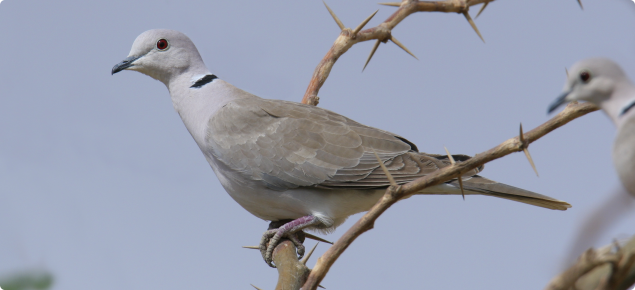Introduction
The Barbary dove (Streptopelia roseogrisea) is also known as the African collared dove, pink-headed dove or rosy-grey turtle-dove. The domestic form is sometimes given its own name of S. “risoria” and some of its common names include the domestic ringdove, domestic collared, fawn or Java dove. The Barbary dove is not indigenous to Australia but is kept as a pet here and overseas. It has established isolated populations in the wild here and in other countries. It poses a serious threat in Australia with significant potential to establish further populations and become a pest, so it is important to immediately report any found in the wild.
Description
The Barbary dove is a medium-sized, sandy or creamy buff bird 29-30cm in length (body and tail). The neck and head are paler, while the chin, underwings and vent area are white or pale cream; the flanks are pale grey. New plumage is tinged mauve-pink on the head, foreneck and breast. The back of the neck has a narrow black half-collar and the undertail has broad white tips. The iris is dark red, the bill black and the feet and legs purple-red.
Males and females are similar. The immature bird is similar to the adult, although the plumage is duller, the half-collar absent and the feet and legs are pale grey.
Domestic forms are generally white or light-coloured, or mottled white and brown, with or without a collar, but with pale bills.
Barbary dove calls include a soft ku-k’rroo and a high-pitched excited heh-heh-heh, sounding like a jeering laugh.
Mistaken identity
In Australia, the barbary dove may be mistaken for other doves and pigeons. However, the predominantly single body colour and lack of markings apart from the black half-collar will usually set it apart from the:
- Bar-shouldered dove (Geopelia humeralis) (eastern and coastal northern Australia)
- Laughing dove (S. senegalensis) (south-western Western Australia)
- Spotted dove (S. chinensis) (coastal eastern and south-eastern Australia; Alice Springs in the Northern Territory; Tasmania; Karratha and south-western Western Australia)
- Domestic pigeon (Columba livia) (all states and territories).
The natural range of the Barbary dove is sub-Saharan Africa from Mauritania to Ethiopia, south east Egypt and the Arabian Peninsula including Saudi Arabia and Yemen. Introduced populations occur in the Canary Islands, the United States and New Zealand. In the Bahamas, Bulgaria, Italy, Japan, Puerto Rico, Spain and the United Kingdom, feral populations occasionally occur in urban areas (where no specific locations are known, the country is not included on the distribution map).

